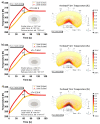Experimental, Theoretical and Numerical Studies on Thermal Properties of Lightweight 3D Printed Graphene-Based Discs with Designed Ad Hoc Air Cavities
- PMID: 37368293
- PMCID: PMC10302392
- DOI: 10.3390/nano13121863
Experimental, Theoretical and Numerical Studies on Thermal Properties of Lightweight 3D Printed Graphene-Based Discs with Designed Ad Hoc Air Cavities
Abstract
The current state of the art on material science emphasizes recent research efforts aimed at designing novel materials characterized by low-density and advanced properties. The present article reports the experimental, theoretical and simulation results on the thermal behavior of 3D printed discs. Filaments of pure poly (lactic acid) PLA and filled with 6 wt% of graphene nanoplatelets (GNPs) are used as feedstocks. Experiments indicate that the introduction of graphene enhances the thermal properties of the resulting materials since the conductivity passes from the value of 0.167 [W/mK] for unfilled PLA to 0.335 [W/mK] for reinforced PLA, which corresponds to a significantly improvement of 101%. Exploiting the potential of 3D printing, different air cavities have been intentionally designed to develop new lightweight and more cost-effective materials without compromising their thermal performances. Furthermore, some cavities are equal in volume but different in the geometry; it is necessary to investigate how this last characteristic and its possible orientations affect the overall thermal behavior compared to that of an air-free specimen. The influence of air volume is also investigated. Experimental results are supported by theoretical analysis and simulation studies based on the finite element method. The results aim to be a valuable reference resource in the field of design and optimization of lightweight advanced materials.
Keywords: 3D printing (FDM); PLA-based filament; numerical simulation; thermal conductivity.
Conflict of interest statement
The authors declare no conflict of interest.
Figures

























References
-
- Reyno T., Marsden C., Wowk D. Surface damage evaluation of honeycomb sandwich aircraft panels using 3D scanning technology. NDT E Int. 2018;97:11–19. doi: 10.1016/j.ndteint.2018.03.007. - DOI
-
- Sadiq S.E., Bakhy S.H., Jweeg M.J. IOP Conference Series: Materials Science and Engineering. Volume 881. IOP Publishing; Bristol, UK: 2020. Crashworthiness behavior of aircraft sandwich structure with honeycomb core under bending load; p. 012046. No. 1.
-
- Bicerano J. Prediction of Polymer Properties. 3rd ed. CRC Press; Boca Raton, FL, USA: 2002.
-
- Mark J., Ngai K., Graessley W., Mandelkern L., Samulski E., Wignall G., Koenig J. Physical Properties of Polymers. 3rd ed. Cambridge University Press; New York, NY, USA: 2004.
Grants and funding
LinkOut - more resources
Full Text Sources

